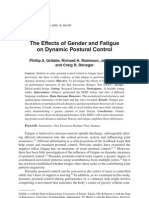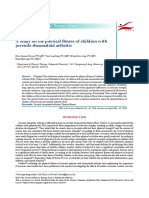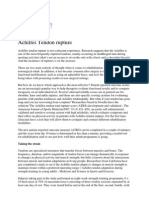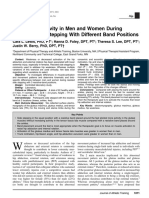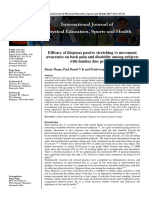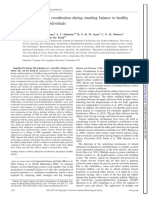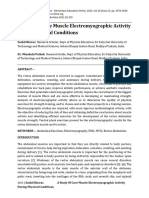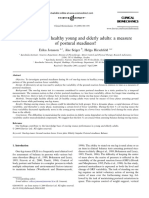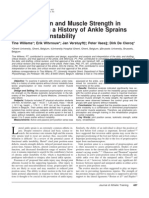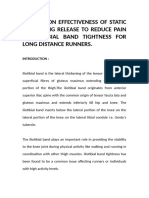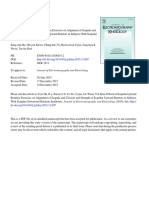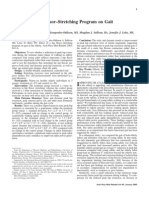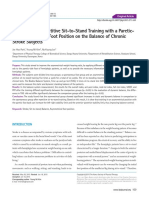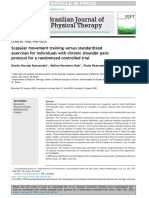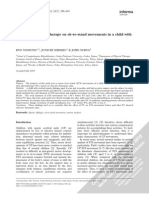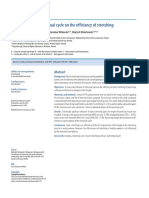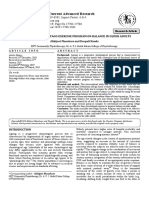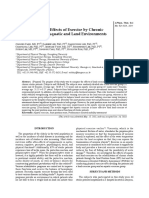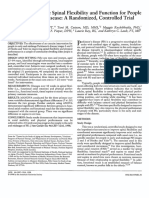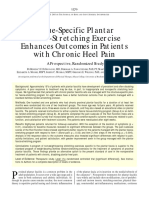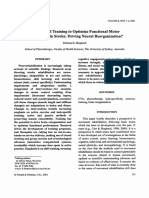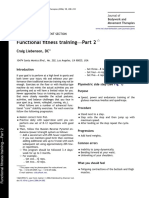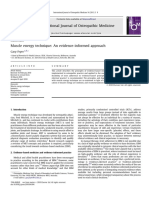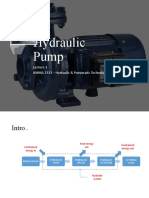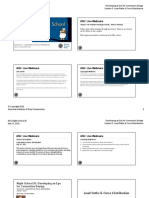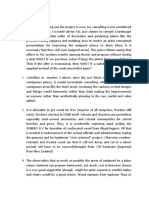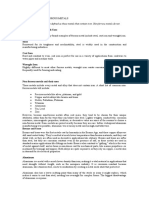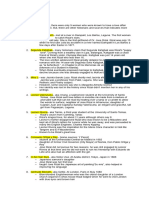Effect of Tai Chi Exercise On Proprioception of Ankle and Knee Joints in Old People
Effect of Tai Chi Exercise On Proprioception of Ankle and Knee Joints in Old People
Uploaded by
Phooi Yee LauCopyright:
Available Formats
Effect of Tai Chi Exercise On Proprioception of Ankle and Knee Joints in Old People
Effect of Tai Chi Exercise On Proprioception of Ankle and Knee Joints in Old People
Uploaded by
Phooi Yee LauOriginal Description:
Original Title
Copyright
Available Formats
Share this document
Did you find this document useful?
Is this content inappropriate?
Copyright:
Available Formats
Effect of Tai Chi Exercise On Proprioception of Ankle and Knee Joints in Old People
Effect of Tai Chi Exercise On Proprioception of Ankle and Knee Joints in Old People
Uploaded by
Phooi Yee LauCopyright:
Available Formats
ORIGINAL ARTICLE
Effect of tai chi exercise on proprioception of ankle and knee
joints in old people
D Xu, Y Hong, J Li, K Chan
. . . . . . . . . . . . . . . . . . . . . . . . . . . . . . . . . . . . . . . . . . . . . . . . . . . . . . . . . . . . . . . . . . . . . . . . . . . . . . . . . . . . . . . . . . . . . . . . . . . . . . . . . . . . . . . . . . . . . . . . . . . . . . .
See end of article for
authors affiliations
. . . . . . . . . . . . . . . . . . . . . . .
Correspondence to:
Professor Hong,
Department of Sports
Science and Physical
Education, The Chinese
University of Hong Kong,
Shatin NT, Hong Kong;
youlianhong@cuhk.edu.hk
Accepted
11 February 2003
. . . . . . . . . . . . . . . . . . . . . . .
Br J Sports Med 2004;38:5054. doi: 10.1136/bjsm.2002.003335
Objectives: To assess if tai chi, a traditional Chinese form of exercise, could improve proprioception in old
people and if the effects of tai chi on proprioception are more evident than other exercise forms in the
elderly.
Methods: By detecting the threshold of passive movement, ankle and knee joint kinaesthesis was measured
in 21 elderly long term tai chi practitioners (TC group), 20 elderly long term swimmers/runners (S/R
group), and 27 elderly sedentary controls (control group).
Results: Ankle joint kinaesthesis differed significantly among the three groups (p = 0.001). Subjects in the
TC group could detect a significantly smaller amount of motion than those in the S/R group (p = 0.022)
and control group (p = 0.001). No significant difference was found between the S/R group and the
control group (p = 0.701). The threshold for detection of passive motion was significantly different in knee
extension and flexion. For knee flexion, the TC group showed a significantly lower mean threshold for
detection of passive motion than the control group (p = 0.026). There were no significant differences
between the S/R group and control group (p = 0.312), or between the TC group and S/R group (p =
0.533). For knee extension, no significant difference was noted among the three groups (p = 0.597).
Conclusions: The elderly people who regularly practiced tai chi not only showed better proprioception at
the ankle and knee joints than sedentary controls, but also better ankle kinaesthesis than swimmers/
runners. The large benefits of tai chi exercise on proprioception may result in the maintenance of balance
control in older people.
T
ai chi, a traditional Chinese exercise, has been practiced
for centuries in China by the elderly and young to attain
agility, balance, and posture control. Its beneficial effects
on health have been observed, and the maintenance of
balance control in older people in particular has drawn
increasing attention from scientific researchers. A number of
cross sectional and longitudinal studies have provided
positive evidence that tai chi practitioners not only have
better cardiorespiratory function,
1 2
but also perform better in
balance control, flexibility, and muscle strength tests.
3 4
Moreover, a study conducted by Wolf et al,
5
with a relatively
large sample size, identified that the intervention of tai chi
reduced the risk of multiple falls by as much as 47.5%.
Although many studies have confirmed the effects of tai chi
exercise on balance control for the elderly, little effort has
been devoted to determining the underlying mechanism.
Postural equilibrium needs proprioceptive acuity and
precise neuromuscular control. Proprioception is the afferent
information that contributes to conscious sensation (muscle
sense), total posture (postural equilibrium), and segmental
posture (joint stability).
6
Many studies have indicated that
proprioception diminishes with age.
79
Gerontologists have
postulated that impaired proprioception makes it difficult for
older people to detect changes in body position until it is too
late for compensatory behaviour to prevent falls.
10
Indeed,
some studies have shown that diminished proprioception is a
major contributing factor to falls in the elderly.
11
It is very
important for old people to retain this ability.
One strategy to reduce the incidence of poor proprioception
and falls with aging may be regular physical activity.
8
Exercise can help to improve a number of sensorimotor
systems that contribute to stability.
12 13
However, different
forms of exercise may have different effects on postural
equilibrium. Gauchard et al
14
reported that proprioceptive
exercise (yoga and soft gymnastics) appeared to have a
greater effect on balance control in the elderly than
bioenergetic physical activities. However, the authors did
not suggest any underlying reasons.
Tai chi exercise requires continuous, slow movement with
small to large expressions of motion, the shift of body weight
from unilateral to bilateral, and circular movements of the
trunk and extremities, involving both isometric and isotonic
contractions. All forms of tai chi emphasise conscious
awareness of body position and movement, which seem to
contain the characteristics of proprioceptive exercise.
15
Therefore does tai chi exercise have particular benefits for
old peoples proprioception? Jacobson et al
16
reported that a
12 week tai chi programme could increase participants
shoulder kinaesthetic sense at 60
. However, the mean (SD)
age of the subjects was 30.4 (4.3) years, and the investigators
did not consider the principal joint systems of the lower
extremity (ankle, knee, and hip) involved in postural control.
This study was therefore designed to investigate the
proprioception of ankle and knee joints in elderly long term
tai chi practitioners, long term swimmers/runners, and
sedentary controls. The purpose was to assess whether long
term tai chi practice could improve proprioception and
whether the effect of tai chi on proprioception was more
evident than other common activities in the elderly. Such
information would help to explain the mechanism whereby
tai chi exercise improves balance.
METHODS
Subj ects
By means of a questionnaire with a complementary interview
about their physical and sporting activities, 68 old people
were recruited to the study. They were predominantly healthy
with no history of major cardiovascular, pulmonary, meta-
bolic, musculoskeletal, or neurological diseases. Twenty one
subjects had regularly practiced tai chi for approximately
50
www.bjsportmed.com
1.5 hours a day over the previous four years or more (TC
group). Twenty subjects had swum and/or run for at least
one hour a day for four or more years (S/R group). The
subjects in the TC and S/R groups had not done any other
regular physical activity in the previous five years. Twenty
seven subjects had not engaged in any regular exercise for
more than four years (control group). No significant
difference was noted in sex, age, height, and weight across
the three groups (table 1).
Each subject gave written informed consent before
participation. The study was approved by the local medical
ethics committee.
Measurement procedures
Joint kinaesthesis is the sensation of joint movement; it is an
important technique used to evaluate proprioception.
Kinaesthesis is usually determined by establishing the
threshold at which passive motion is detected, an assessment
of the ability to detect relatively slow passive joint motion.
17
We used it to assess knee and ankle joint proprioception.
Testing was performed in a well lit and well ventilated
room. The room was sound attenuated and isolated so as to
reduce any auditory or visual interference that might distract
the participants. After their weight and height had been
measured, each subject participated in two separate data
collection sessions: measurement of ankle joint kinaesthesis
and, after a brief rest period, measurement of knee joint
kinaesthesis.
Ankl e j oi nt ki naest hesi s t est
Data were collected using the instrumentation and proce-
dures described by Lentell et al
18
with minor modifications. As
illustrated in fig 1, the custom made device is a box with a
movable platform that rotates about a single axis in two
directions. With the foot resting on this platform, plantar
dorsiflexion of ankle movements can occur. This platform is
moved by an electric motor which rotates the foot on an axis
at a rate of 0.4
/s. Movement can be stopped at any time by
the use of a hand held switch. The angular displacement
achieved by the platform is calculated by the dents that the
motor rotates.
The device is also equipped with a hanging scale and a
fixed pulley supported by a trestle, which is outside of the
device. A thigh cuff attached to the lower end of the scale is
wrapped around the lower thigh of the subject. By adjust-
ment of the length of the cuff, the extremity is lifted by the
scale, and its weight is recorded when the subject fully
relaxes the thigh. The thigh cuff is then attached to one end
of the rope around the pulley and the other end is hung with
weights. The extremity can then be adjusted to where the
foot is in contact with the platform. By adding or reducing
the weights, the investigator can standardise the weight of
the lower extremity resting on the platform during testing.
For data collection, each subject was seated on an
adjustable chair and his or her dominant foot was placed
on the platform so that the axis of the apparatus coincided
with the plantar dorsiflexion axis of the ankle joint. The hip,
knee, and ankle were positioned at 90
. To standardise the
sensory cues from the contact between the instrument and
the plantar surface of the foot, 50% of the lower extremity
weight was rested on the platform by the use of the thigh cuff
suspension system. During testing, subjects kept their eyes
closed and wore headphones with music playing to eliminate
visual and auditory stimuli from the testing apparatus.
Each test movement began with the foot placed on the
horizontal platformthat is, the starting position was 0
. The
subjects were instructed to concentrate on their foot and to
press the hand switch when they could sense motion and
identify the direction of the movement. After two practice
trials had been performed, the motor was engaged to rotate
the foot into dorsiflexion or plantarflexion at a random time
interval between two and ten seconds after subject instruc-
tion. The researcher recorded the rotation angles of the
platform and the direction of movements as passive motion
sense. At least six randomised trials were conducted: three
for plantarflexion, three for dorsiflexion. The mean values of
the three angles sensed in one direction were calculated.
Knee j oi nt ki naest hesi s t est
The method of assessing knee kinaesthesis was similar to
those described in previous studies.
7 19
As shown in fig 2, the
apparatus consists of electric motor, governor, counter
system, transmission, and linkage system. A moveable frame
can rotate around a single axis in two directions at a velocity
of 0.4
/s. Angular displacement of the frame is calculated by
the dents that the motor rotates.
Each subject performed two practice tests to become
familiar with the test process before completing the trials.
At least six randomised trials (three trials for extension, three
trials for flexion) were performed on the dominant leg
according to the following protocol. The subjects wore shorts
to negate any extraneous skin sensation from clothing at the
knee area. They sat in an adjustable chair with legs hanging
Table 1 Characteristics of elderly tai chi practitioners
(TC group), swimmers/runners (S/R group), and
sedentary controls (Control group)
Group Age (years) Height (cm) Weight (kg)
TC (n =21, 12M, 9F) 66.1 (5.2) 163.6 (7.9) 64.8 (9.9)
S/R (n =20, 12M, 8F) 65.4 (3.0) 164.1 (8.6) 66.5 (12.4)
Control (n =27, 15M, 12F) 65.6 (3.9) 163.9 (7.8) 68.5 (10.9)
Values are mean (SD).
M, male; F, female.
Figure 1 Testing apparatus and a subject positioned for evaluation of
passive movement sense of ankle.
Tai chi exercise and proprioception 51
www.bjsportmed.com
freely over the edge of the seat 5 cm proximal to the popliteal
fossa. A custom made inflatable cuff was fitted above the
knee joint and inflated to 20 mm Hg to neutralise cutaneous
sensation. The axis of rotation of the knee joint was aligned
with the axis of rotation of the frame. Then the researcher
placed the lower part of the shank of the subject on the
frame. An ankle inflatable cuff was applied and inflated to
20 mm Hg to reduce multisensory afferent discharge at the
shank-machine interface. To further reduce unwanted
sensory input, the subjects kept their eyes closed and wore
headphones with music playing to eliminate the sight and
sound of the apparatus.
The starting position of each trial was 45
of knee flexion as
measured by an electrogoniometer (Penny and Giles,
Christchurch, Dorset, UK). Subjects were told that their legs
could move in a flexed or extended direction beginning at a
random delay of 210 seconds after the examiner signalled
the start of the test. Once the subject detected motion of the
leg, he or she pressed a hand held stop button and confirmed
the direction of the motion. The rotation angles of the frame
were defined as the threshold of detection for the knee joint.
Mean values of three trials in one direction were used for
analysis.
Data anal ysi s
All variables are presented as mean (SD). Values for passive
motion sense of ankle and knee joint in different directions
were respectively compared using paired t test in each group.
Because there were no significant differences between the
directions of ankle movement, plantarflexion, and dorsiflex-
ion, data were averaged to produce ankle kinaesthesis. One
way analysis of variance was used to estimate significant
differences among groups. Post hoc Scheffe tests were
performed when necessary to isolate the differences, and
p(0.05 was considered significant.
RESULTS
Ankl e j oi nt ki naesthesi s
Ankle joint kinaesthesis differed significantly among the
three groups (p = 0.001). Movements of 1.21 (0.33)
were
perceived in the TC group, 1.78 (0.82)
in the S/R group, and
1.95 (0.66)
in the sedentary control group. The post hoc test
showed that the TC group could detect a significantly smaller
amount of motion than the control group (p = 0.001) and S/
R group (p = 0.022), while no significant difference was
found between the S/R group and sedentary control group (p
= 0.701) (fig 3).
Knee j oi nt ki naesthesi s
The threshold for detection of passive motion was signifi-
cantly different in extension and flexion for each group; the
knees were more sensitive to a flexion arc than to an
extension arc. One way analysis of variance indicated
significant differences in passive motion sense in knee
flexion across the three groups (p = 0.025). Further analysis
showed that the TC group had a significantly lower mean
threshold for detection of passive motion than the subjects in
the control group (p = 0.026). There were no significant
differences between the S/R group and control group (p =
0.312), or between the TC group and S/R group (p = 0.533).
For knee extension, no significant difference was found
among the three groups (p = 0.597) (fig 4).
DI SCUSSI ON
Although many studies have indicated that adoption of
regular physical activity can attenuate the age related decline
in many physiological systems, few have examined the
effects of exercise on proprioception of old people, especially
Figure 2 Customised apparatus used to test passive motion sense of the
knee joint.
Figure 4 Comparison of knee kinaesthesis in elderly tai chi
practitioners (TC group), swimmers/runners (S/R group), and sedentary
controls (Control group). Error bars indicate SEM. *p,0.05 compared
with the TC group.
Figure 3 Comparison of ankle kinaesthesis in elderly tai chi
practitioners (TC group), swimmers/runners (S/R group), and sedentary
controls (Control group). Error bars indicate SEM. **p,0.01, *p,0.05
compared with the TC group.
52 Xu, Hong, Li, et al
www.bjsportmed.com
the effects of different kinds of exercise. Our study shows
that long term tai chi practitioners not only have better ankle
and knee joint kinaesthesis than sedentary controls but also
their ankle joint kinaesthesis is better than regular swim-
mers/runners. Furthermore, the latter did not perform any
better in ankle and knee joint kinaesthesis tests than their
sedentary counterparts.
The postural control system operates as a control circuit
between the sensory sources, central nervous system, and the
musculoskeletal system. Proprioceptors and visual and
vestibular centres contribute afferent information to the
central nervous system on body position and balance.
20
Colledge and his colleagues
21
studied the relative contribu-
tions to balance of vision, proprioception, and the vestibular
system in different age groups. They found all age groups
were more dependent on proprioception than on vision for
the maintenance of balance. Camicioli et al
22
also showed that
disruption of proprioceptive input was the most important
determinant of quantitative balance performance in subjects
older than 80 years. Thus proprioception may greatly
influence postural stability, and a decline in proprioception
with aging could be associated with the increased propensity
of elderly people to fall.
8
The considerable benefits of tai chi
exercise on proprioception may have significance for old
people in maintaining balance.
Training has been widely reported to be one of the best
ways to improve balance in the elderly.
2325
However, different
kinds of exercise have been shown to have different effects
on balance. Gauchard et al
14
chose yoga and soft gymnastics
as proprioceptive exercise, which consist of slow movements
performed sequentially under different postural conditions;
they compared the effects of proprioceptive exercise, bioener-
getic physical activities (swimming, cycling, or jogging), and
no exercise on postural control in elderly people. The results
indicate that muscular strength was significantly increased in
the bioenergetic exercise group, but proprioceptive exercise
appeared to have the greatest effect on balance control. The
authors pointed out that the ritual motions of tai chi are also
proprioceptive exercise. From our results showing that elderly
tai chi practitioners have improved proprioception, we
suggest that maintaining, or delaying the decline, in
proprioception is closely associated with tai chi exercise
improving balance control in old people.
Tai chi exercise is a series of individual graceful movements
in a slow, continuous, circular pattern. In performing tai chi,
awareness of movement sequencing starts from the feet,
ankles, and legs, and the strong thigh muscles are used to
concentrate the movement through and around the turning
of the hips and waist, with the latter acting as the axis
around which all body movements are executed. The move-
ments of tai chi are gracefully fluent and consummately
precise because specificity of joint angles and body position is
of critical importance in accurately and correctly performing
each form.
16
Acute awareness of body position and movement
is demanded by the nature of the activity. Thus it is logical
that the practice of tai chi has benefits for proprioception,
which is confirmed by our study.
Swimming and running are two of the most common
exercises practiced by elderly people; they are excellent
forms of aerobic exercise, and provide good training stimuli
for cardiopulmonary function and muscle strength. Com-
pared with tai chi, swimming and running involve cyclic
repetitive actions. Awareness of joint position and move-
ment is not emphasised during these exercise forms. In
addition, most elderly people exercise only to enhance health
and for recreation; they usually do not pay much attention to
joint position and angles during exercise, unless such
awareness is required in certain forms of exercise, such as
tai chi. This may help to explain why the swimmers/runners
did not have better scores for knee and ankle kinaesthesis in
this study.
It is of particular interest that the effects of tai chi on
proprioception were different in the knee and ankle joints.
The effect on ankle joint kinaesthesis was more prominent
than on knee joint kinaesthesis. The passive motion sense of
the ankle joint in the TC group was significantly better than
in both the sedentary control group and the S/R group.
However, for the knee joint, tai chi exercise only produced a
better effect than in the sedentary control group. These
results may be attributable to the characteristics of tai chi
movements. The old tai chi proverb states, When performing
tai chi, the feet act as roots. Although almost all tai chi
forms are performed in a semi-squat position, which
enhances the loading of the muscles and motion ranges of
the knee joints, the continuous transformation of different
postures and steps cause more changes in ankle joint
movements, such as turning the toes outward or inward
and raising or lowering the toes. Moreover, while making a
stride, foot placement is slow and deliberate. These move-
ments may help to retain the sensitivity of proprioceptors
located in the joint capsules, ligaments, tendons, and
muscles.
Ankle proprioception is very important for the elderly to
maintain proper postural control. Many studies have indi-
cated that the movement pattern for postural correction in
elderly adults is different from that of young adults. The
elderly rely more on hip movements, while young people rely
on ankle movements to control postural stability.
26
A decline
in somatosensory information from the feet is a major factor
in this pattern change with age.
27
Therefore the considerable
impact of tai chi practice on ankle proprioception is of great
benefit in the retention of balance control in old people.
The decline in proprioception with age may be an
important contributing factor to falls in the elderly, and this
may be influenced by regular physical activity. This study
shows that, compared with other common activities, long
term tai chi exercise may have more benefit in retaining
proprioception of the ankle and knee joints, which may be
valuable for maintaining balance control in the elderly.
ACKNOWLEDGEMENTS
This work was fully supported by a grant from the Research Grants
Council of the Hong Kong Special Administrative Region (project no
CUHK4360/00H).
Authors affiliations
. . . . . . . . . . . . . . . . . . . . .
D Xu, Y Hong, J Li, Department of Sports Science and Physical
Education, The Chinese University of Hong Kong
K Chan, Department of Orthopedics and Traumatology, The Chinese
University of Hong Kong
REFERENCES
1 Lai JS, Lan C, Wong MK, et al. Two-year trends in cardiorespiratory function
among older Tai Chi Chuan practitioners and sedentary subjects. J Am Geriatr
Soc 1995;44:12227.
Take home message
The elderly people who regularly practiced tai chi not only
showed better proprioception of the ankle and knee joints
than sedentary controls, but also showed better ankle
kinaesthesis than elderly regular swimmers/runners. The
prominent benefits of tai chi exercise on proprioception may
be helpful in maintaining balance control in the elderly.
Tai chi exercise and proprioception 53
www.bjsportmed.com
2 Young DR, Appel LJ, Jee SH, et al. The effects of aerobic exercise and Tai Chi
on blood pressure in older people: results of a randomized trial. J Am Geriatr
Soc 1999;47:27784.
3 Hong Y, Li JX, Robinson PD. Balance control, flexibility, and cardiorespiratory
fitness among older Tai Chi practitioners. Br J Sports Med 2000;34:2934.
4 Tse SK, Bailey DM. Tai chi and postural control in the well elderly. Am J Occup
Ther 1992;46:295300.
5 Wolf SL, Barnhart HX, Kutner NG, et al. Reducing frailty and falls in older
persons: an investigation of Tai Chi and computerized balance training. J Am
Geriatr Soc 1996;44:48997.
6 Lephart SM, Pincivero DM, Giraldo JL, et al. The role of proprioception in the
management and rehabilitation of athletic injuries. Am J Sports Med
1997;25:1307.
7 Pai YC, Rymer WZ, Chang RW, et al. Effect of age and osteoarthritis on knee
proprioception. Arthritis Rheum 1997;40:22605.
8 Petrella RJ, Lattanzio PJ, Nelson MG. Effect of age and activity on knee joint
proprioception. Am J Phys Med Rehab 1997;76:23541.
9 Skinner HB, Barrack RL, Cook SD. Age-related decline in proprioception. Clin
Orthop 1984;184:20811.
10 Robbins S, Waked E, McClaran J. Proprioception and stability: foot position
awareness as a function of age and footwear. Age Ageing 1995;24:6772.
11 Mion LC, Gregor S, Buettner M, et al. Falls in the rehabilitation setting:
incidence and characteristics. Rehabil Nurs 1989;14:1722.
12 Lord SR, Ward JA, Williams P, et al. Physiological factors associated with falls
in older community-dwelling women. J Am Geriatr 1994;42:1721.
13 Lord SR, Rogers MS, Howland A, et al. Lateral stability, sensorimotor function
and falls in older people. J Am Geriatr 1999;47:107781.
14 Gauchard GC, Jeandel C, Tessier A, et al. Beneficial effect of proprioceptive
physical activities on balance control in elderly human subjects. Neurosci Lett
1999;273:814.
15 Irrgang JJ, Neri R. The rationale for open and closed kinetic chain activities for
restoration of proprioception and neuromuscular control following injury. In:
Lephart SM, Fu FH, eds. Proprioception and neuromuscular control in joint
stability. Champaign, IL: Human Kinetics, 2000:36374.
16 Jacobson BH, Chen HC, Cashel C, et al. The effect of Tai Chi Chuan training
on balance, kinesthetic sense, and strength. Percept Mot Skills
1997;84:2733.
17 Rozzi S, Yuktanandana P, Pincivero D, et al. Role of fatigue on proprioception
and neuromuscular control. In: Lephart SM, Fu FH, eds. Proprioception and
neuromuscular control in joint stability. Champaign, IL: Human Kinetics,
2000:37583.
18 Lentell G, Baas B, Lopez D, et al. The contributions of proprioceptive deficits,
muscle function, and anatomic laxity to functional instability of the ankle.
J Orthop Sports Phys Ther 1995;21:20615.
19 Beynnon BD, Renstrom PA, Konradsen L, et al. Validation of techniques to
measure knee proprioception. In: Lephart SM, Fu FH, eds. Proprioception and
neuromuscular control in joint stability. Champaign, IL: Human Kinetics,
2000:12738.
20 Guyton AC. Textbook of medical physiology. London: Saunders, 1991.
21 Colledge NR, Cantley P, Peaston I, et al. Ageing and balance: the
measurement spontaneous sway by posturography. Gerontology
1994;40:2738.
22 Camicioli R, Panzer VP, Kaye J. Balance in the healthy elderly: posturography
and clinical assessment. Arch Neurol 1997;54:97698.
23 Buchner DM, Cress ME, Lateur BJ, et al. The effect of strength and endurance
training on gait, balance, fall risk, and health services use in community-living
older adults. J Gerontol 1997;52:M21824.
24 Wolfson L, Whipple R, Judge J, et al. Training balance and strength in the
elderly to improve function. J Am Geriatr Soc 1993;41:3413.
25 Woollacott MH, Moore S, Hu MH. Improvements in balance in the elderly
through training in sensory organization abilities. In: Stelmach GE,
Homberg V, eds. Sensorimotor impairment in the elderly. Boston: Kulwer
Academic Publishers, 1993:37792.
26 Okada S, Hirakawa K, Takada Y, et al. Age-related differences in postural
control in humans in response to a sudden deceleration generated by postural
disturbance. Eur J Appl Physiol 2001;85:1018.
27 Manchester D, Woollacott M, Zederbauer-Hylton N, et al. Visual, vestibular
and somatosensory contributions to balance control in the older adult.
J Gerontol 1989;44:M11827.
54 Xu, Hong, Li, et al
www.bjsportmed.com
You might also like
- Critical Reading and Writing in The Digital Age - An Introductory Coursebook, Second EditionDocument350 pagesCritical Reading and Writing in The Digital Age - An Introductory Coursebook, Second Editiondavid0% (1)
- P772 2 2011Document13 pagesP772 2 2011Simanto RoyNo ratings yet
- The Kankakee: River of HistoryDocument153 pagesThe Kankakee: River of HistoryBrian Capouch100% (1)
- Fatiga y Control Postural DinamicoDocument19 pagesFatiga y Control Postural DinamicoPatricio Alejandro Gaete PobleteNo ratings yet
- Influence of Pistol Squat On Decline AngDocument10 pagesInfluence of Pistol Squat On Decline Angpedroalmeidaferro17No ratings yet
- Effect of Jumping Exercise On Muscle Strength and Balance of Elderly People: A Randomized Controlled TrialDocument4 pagesEffect of Jumping Exercise On Muscle Strength and Balance of Elderly People: A Randomized Controlled TrialAntonia SanchezNo ratings yet
- Association Between Walking Ability and Trunk and Lower-Limb Muscle Atrophy in Institutionalized Elderly Women: A Longitudinal Pilot StudyDocument6 pagesAssociation Between Walking Ability and Trunk and Lower-Limb Muscle Atrophy in Institutionalized Elderly Women: A Longitudinal Pilot StudyItai IzhakNo ratings yet
- Ijerph 16 03509Document11 pagesIjerph 16 03509Chloe BujuoirNo ratings yet
- 2017 - Kwon - A Study On The Physical Fitness On Children With JRADocument6 pages2017 - Kwon - A Study On The Physical Fitness On Children With JRAkenmitaNo ratings yet
- Effects of Respiratory-Muscle Exercise On Spinal CurvatureDocument6 pagesEffects of Respiratory-Muscle Exercise On Spinal CurvatureChris100% (1)
- 10 3390@medicina57070702Document7 pages10 3390@medicina57070702Einar Cumplido MartínezNo ratings yet
- 슈로스 (Schroth) 운동치료와 슬링운동치료가 척추측만증 환자의 유연성, 균형능력, 척추각 및 흉곽 확장에 미치는 효과 비교Document13 pages슈로스 (Schroth) 운동치료와 슬링운동치료가 척추측만증 환자의 유연성, 균형능력, 척추각 및 흉곽 확장에 미치는 효과 비교kang soon cheolNo ratings yet
- The Effects of Pilates Exercise On Cardiopulmonary Function in The Chronic Stroke Patients A Randomized Controlled Trials PDFDocument5 pagesThe Effects of Pilates Exercise On Cardiopulmonary Function in The Chronic Stroke Patients A Randomized Controlled Trials PDFImam santosoNo ratings yet
- Achilles TendonDocument2 pagesAchilles TendonojuditaNo ratings yet
- 2018 - Side Stepping With Elastics Bands and Gluteal EMGDocument11 pages2018 - Side Stepping With Elastics Bands and Gluteal EMGdiego rocioNo ratings yet
- Randomised Controlled Trial of Pelvic Floor Muscle Exercises and Manometric Biofeedback For Erectile Dysfunction British Journal of General PracticeDocument2 pagesRandomised Controlled Trial of Pelvic Floor Muscle Exercises and Manometric Biofeedback For Erectile Dysfunction British Journal of General PracticeJoice CambaliNo ratings yet
- The Effect of Hip Joint Exercise Using An Elastic Band On Dynamic Balance, Agility and Flexibility in Healthy Subjects: A Randomized Controlled TrialDocument7 pagesThe Effect of Hip Joint Exercise Using An Elastic Band On Dynamic Balance, Agility and Flexibility in Healthy Subjects: A Randomized Controlled TrialIndahMardhNo ratings yet
- Working With The Older Client Part 1 Article 2016Document6 pagesWorking With The Older Client Part 1 Article 2016ChrisGellertNo ratings yet
- IJRAR24B2390Document4 pagesIJRAR24B2390prathamesh nikamNo ratings yet
- Efficacy of Iliopsoas Passive StretchingDocument4 pagesEfficacy of Iliopsoas Passive StretchingmathewkgkutrapililNo ratings yet
- Adaptation of Multijoint Coordination During Standing Balance in Healthy Young and Healthy Old IndividualsDocument14 pagesAdaptation of Multijoint Coordination During Standing Balance in Healthy Young and Healthy Old IndividualsebrahimpanNo ratings yet
- Effect of Isometric Quadriceps Exercise On Muscle StrengthDocument7 pagesEffect of Isometric Quadriceps Exercise On Muscle StrengthAyu RoseNo ratings yet
- PQ Art 47262-10Document6 pagesPQ Art 47262-10tayfunertebelNo ratings yet
- A Study of Core Muscle Electromyographic Activity During Physical ConditionsDocument7 pagesA Study of Core Muscle Electromyographic Activity During Physical ConditionsEsteban AmayaNo ratings yet
- Jurnal Balance Exercise 3Document7 pagesJurnal Balance Exercise 3Layar MutiaraNo ratings yet
- Effects of Kinesio Taping in Rectus Femoris Activity and Sit-To-Stand Movement in Children With Unilateral Cerebral Palsy - Placebo-Controlled, Repeated-Measure Design 2018Document12 pagesEffects of Kinesio Taping in Rectus Femoris Activity and Sit-To-Stand Movement in Children With Unilateral Cerebral Palsy - Placebo-Controlled, Repeated-Measure Design 2018Maria Del Mar Marulanda GrizalesNo ratings yet
- One Leg StandingDocument7 pagesOne Leg StandingPhooi Yee LauNo ratings yet
- Aaa - THAMARA - Comparing Hot Pack, Short-Wave Diathermy, Ultrasound, and Tens On Isokinetic Strength, Pain and Functional StatusDocument9 pagesAaa - THAMARA - Comparing Hot Pack, Short-Wave Diathermy, Ultrasound, and Tens On Isokinetic Strength, Pain and Functional StatusBruno FellipeNo ratings yet
- JurnalDocument7 pagesJurnalghozi hilmyNo ratings yet
- Obesity CuadricepsDocument5 pagesObesity CuadricepsGonzalo Aguayo AlcayagaNo ratings yet
- 1802 HGDocument6 pages1802 HGDavid SugiartoNo ratings yet
- 1.research PaperDocument18 pages1.research PaperbinNo ratings yet
- A Comprehensive Exercise Program Improves Foot Alignment in People With Flexible Flat Foot: A Randomised TrialDocument5 pagesA Comprehensive Exercise Program Improves Foot Alignment in People With Flexible Flat Foot: A Randomised Trial黃子庭No ratings yet
- Proprioception and Muscle Strength in Subjects With A History of Ankle Sprains and Chronic InstabilityDocument7 pagesProprioception and Muscle Strength in Subjects With A History of Ankle Sprains and Chronic InstabilityEvelyn_D_az_Ha_8434No ratings yet
- Anusha Article IJIRMFDocument5 pagesAnusha Article IJIRMFAnusha SampathNo ratings yet
- G.S.NISHANTHINI Final Yr ProjectDocument15 pagesG.S.NISHANTHINI Final Yr Projectdr.nishanthini86No ratings yet
- Determining The Stabilizing Role of Individual Torso Muscles During Rehabilitation ExercisesDocument13 pagesDetermining The Stabilizing Role of Individual Torso Muscles During Rehabilitation Exercisesx-ray7No ratings yet
- Effects of Obesity and Chronic Low Back Pain On Gait: Research Open AccessDocument7 pagesEffects of Obesity and Chronic Low Back Pain On Gait: Research Open AccessHumberto CastroNo ratings yet
- Caption Sheet 2-Kailynn BDocument5 pagesCaption Sheet 2-Kailynn Bapi-549116310No ratings yet
- Accepted ManuscriptDocument40 pagesAccepted ManuscriptDaniel CarcamoNo ratings yet
- Effect of A Hip Flexor Stretching Program On Gait in The Elderly. 2Document6 pagesEffect of A Hip Flexor Stretching Program On Gait in The Elderly. 2George M. PamborisNo ratings yet
- JKPT027 03 169Document5 pagesJKPT027 03 169Hendra Guntur BarunaNo ratings yet
- Glut MedMaxDocument12 pagesGlut MedMaxColm CoakleyNo ratings yet
- Kamonseki 2020Document10 pagesKamonseki 2020Nicol Sandoval SotoNo ratings yet
- Electromyographic Activity of Rectus Abdominis Muscles During Dynamic Pilates Abdominal ExercisesDocument8 pagesElectromyographic Activity of Rectus Abdominis Muscles During Dynamic Pilates Abdominal ExercisesNuno RodolfoNo ratings yet
- The Effect of Physiotherapy On Sit-To-Stand Movements in A Child With Spastic DiplegiaDocument9 pagesThe Effect of Physiotherapy On Sit-To-Stand Movements in A Child With Spastic DiplegiaequalbenNo ratings yet
- Springer, Pincivero - 2009 - Gait & Posture The Effects of Localized Muscle and Whole-Body Fatigue On Single-Leg Balance Between HealthyDocument5 pagesSpringer, Pincivero - 2009 - Gait & Posture The Effects of Localized Muscle and Whole-Body Fatigue On Single-Leg Balance Between HealthyAwatef FituriNo ratings yet
- Kim Et Al - Emg, Core - 2016Document27 pagesKim Et Al - Emg, Core - 2016Lina M GarciaNo ratings yet
- The Influence of Menstrual Cycle On The Efficiency of StretchingDocument7 pagesThe Influence of Menstrual Cycle On The Efficiency of StretchingAlejandra GutierrezNo ratings yet
- International Journal of Current Advanced Research International Journal of Current Advanced ResearchDocument5 pagesInternational Journal of Current Advanced Research International Journal of Current Advanced ResearchI Made Dhita PriantharaNo ratings yet
- Dafpus 11Document9 pagesDafpus 11Cut MulianiNo ratings yet
- The Effects of Kinesio Taping On Quadriceps Strenth During Isokinetic Exercise in Healthy Non-Athlete WomenDocument6 pagesThe Effects of Kinesio Taping On Quadriceps Strenth During Isokinetic Exercise in Healthy Non-Athlete WomenionNo ratings yet
- Acute Aquatic Treadmill Exercise Improves Gait and Pain in People With Knee OsteoarthritisDocument7 pagesAcute Aquatic Treadmill Exercise Improves Gait and Pain in People With Knee OsteoarthritisBlajiu BeatriceNo ratings yet
- The Effects of Pilates Based Exercise On Dynamic Balance in Healthy AdultsDocument5 pagesThe Effects of Pilates Based Exercise On Dynamic Balance in Healthy AdultsIka Nindyas RanitadewiNo ratings yet
- Comparison of The Effects of Exercise by Chronic Stroke Patients in Aquatic and Land EnvironmentsDocument4 pagesComparison of The Effects of Exercise by Chronic Stroke Patients in Aquatic and Land Environmentsilona ilincaNo ratings yet
- Schenkman: Exercise To Improve Spinal Flexibility and Function For People With Parkinson's Disease: A Randomized, Controlled TrialDocument10 pagesSchenkman: Exercise To Improve Spinal Flexibility and Function For People With Parkinson's Disease: A Randomized, Controlled TrialGerman BuyattiNo ratings yet
- Effects of Balance Evaluation Comparison of Dynamic Balance and Y BalanceDocument5 pagesEffects of Balance Evaluation Comparison of Dynamic Balance and Y Balancethodoras--No ratings yet
- Anatomy for Strength and Fitness Training for Women: An Illustrated Guide to Your Muscles in ActionFrom EverandAnatomy for Strength and Fitness Training for Women: An Illustrated Guide to Your Muscles in ActionRating: 4 out of 5 stars4/5 (4)
- Science of Stretch: Reach Your Flexible Potential, Stay Active, Maximize MobilityFrom EverandScience of Stretch: Reach Your Flexible Potential, Stay Active, Maximize MobilityNo ratings yet
- Basic Exercise Physiology: Clinical and Laboratory PerspectivesFrom EverandBasic Exercise Physiology: Clinical and Laboratory PerspectivesNo ratings yet
- Archery Anatomy: An Introduction to Techniques for Improved PerformanceFrom EverandArchery Anatomy: An Introduction to Techniques for Improved PerformanceRating: 4 out of 5 stars4/5 (1)
- Improving Ankle and Knee Joint Stability: Proprioceptive Balancefit Discs DrillsFrom EverandImproving Ankle and Knee Joint Stability: Proprioceptive Balancefit Discs DrillsNo ratings yet
- DiGiovanni 2003 PDFDocument8 pagesDiGiovanni 2003 PDFPhooi Yee LauNo ratings yet
- Training To Optimize Performance Driving Reorganization?: Exercise and Functional in Stroke: NeuralDocument10 pagesTraining To Optimize Performance Driving Reorganization?: Exercise and Functional in Stroke: NeuralPhooi Yee LauNo ratings yet
- Bourcher, NeckpainbalanceDocument7 pagesBourcher, NeckpainbalancePhooi Yee LauNo ratings yet
- Kristenen, NeckmusclebalanceDocument9 pagesKristenen, NeckmusclebalancePhooi Yee LauNo ratings yet
- Functional Fitness Testing PDFDocument3 pagesFunctional Fitness Testing PDFPhooi Yee LauNo ratings yet
- Muscle Energy PDFDocument7 pagesMuscle Energy PDFPhooi Yee LauNo ratings yet
- 33528081Document447 pages33528081Vishnu KPNo ratings yet
- InnovationDocument17 pagesInnovationKashif DiyanathullahNo ratings yet
- BMMM2333 Lecture 3 Hydraulic PumpDocument39 pagesBMMM2333 Lecture 3 Hydraulic PumpFgj JhgNo ratings yet
- 1.1FWord To FigureDocument5 pages1.1FWord To FigureShe SheNo ratings yet
- Mar Jun 17 Hybrid F8 QPDocument4 pagesMar Jun 17 Hybrid F8 QPsweet007samNo ratings yet
- Infodatin Tuberkulosis 2018Document25 pagesInfodatin Tuberkulosis 2018Yulianto WijayaNo ratings yet
- ns26 - 3 Connection Design Handout - 4perDocument28 pagesns26 - 3 Connection Design Handout - 4perHectorNo ratings yet
- Conveyor 23 SPC-2760319-0101Document372 pagesConveyor 23 SPC-2760319-0101dmitriy.astakhovNo ratings yet
- Itapuih - Om - Kumpulan Connective Words Lengkap Beserta Contoh. ConnectiveDocument4 pagesItapuih - Om - Kumpulan Connective Words Lengkap Beserta Contoh. ConnectiveSamuel FerdinandNo ratings yet
- NSTP SUGGESTionDocument3 pagesNSTP SUGGESTionRose Ann Espinas TenaNo ratings yet
- Organizational Behavior: Eighteenth Edition, Global EditionDocument30 pagesOrganizational Behavior: Eighteenth Edition, Global Editionsarlagrover100% (1)
- Ferrous and Non Ferrous MetalsDocument4 pagesFerrous and Non Ferrous MetalsLyka Balacdao100% (1)
- Ba-Psychology Syllabus 7720190813.154132Document62 pagesBa-Psychology Syllabus 7720190813.154132DENIZE DSOUZANo ratings yet
- Low Voltage EquipmentDocument174 pagesLow Voltage EquipmentFarid NazriNo ratings yet
- Rizal's WomenDocument2 pagesRizal's WomenDanny Limpag EngcotNo ratings yet
- MSMWHS200 AT1 S Safety 210125Document2 pagesMSMWHS200 AT1 S Safety 210125MNo ratings yet
- Lesson Plan: Unit 1: My Funny Friend Lesson 7&8: Listening, Speaking and WritingDocument4 pagesLesson Plan: Unit 1: My Funny Friend Lesson 7&8: Listening, Speaking and WritingThúy Võ ThịNo ratings yet
- PT3 Maths IX (1)Document8 pagesPT3 Maths IX (1)nitarstgNo ratings yet
- Csa ArtikelDocument13 pagesCsa ArtikelSilvi Eka PutriNo ratings yet
- 13 01 2023 - CSE3009 IOT BK WebSocket XMPP DDSDocument14 pages13 01 2023 - CSE3009 IOT BK WebSocket XMPP DDSMann PandyaNo ratings yet
- Putsch Flume Water Treatment SystemDocument28 pagesPutsch Flume Water Treatment Systemguillo tapiaNo ratings yet
- ON/OFF Zone Valves (PN 16) AMZ 112, AMZ 113: Data SheetDocument8 pagesON/OFF Zone Valves (PN 16) AMZ 112, AMZ 113: Data SheetAndrei-Lucian MilitaruNo ratings yet
- Body Language TrainingDocument7 pagesBody Language TrainingmagihzarasanNo ratings yet
- Cables For VFDDocument2 pagesCables For VFDAndavilli Srihari KumarNo ratings yet
- 071-8805-00 Karrera User ManualDocument370 pages071-8805-00 Karrera User Manualtudor pirvuNo ratings yet
- Inspection of Electric EquipmentDocument26 pagesInspection of Electric Equipmentkalyan ReddyNo ratings yet
- Recovering The Female Voice in Islamic Scripture Women and Silence Georgina L. Jardim 2024 Scribd DownloadDocument82 pagesRecovering The Female Voice in Islamic Scripture Women and Silence Georgina L. Jardim 2024 Scribd Downloaddyebsalion100% (5)



